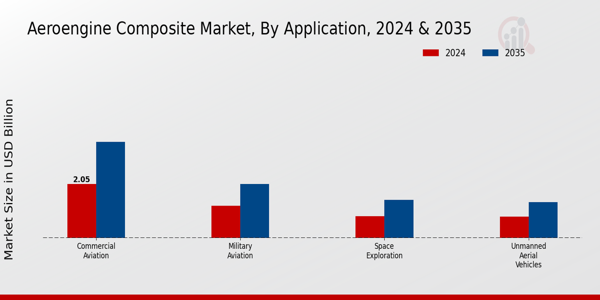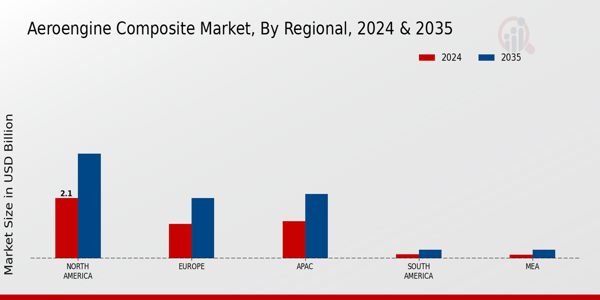Aeroengine Composite Market Overview
Aeroengine Composite Market Size was estimated at 4.65 (USD Billion) in 2023. The Aeroengine Composite Market is expected to grow from 4.89 (USD Billion) in 2024 to 8.5 (USD Billion) by 2035. The Aeroengine Composite Market CAGR (growth rate) is expected to be around 5.16% during the forecast period (2025 - 2035).
 Source Primary Research, Secondary Research, Market Research Future Database and Analyst Review
Source Primary Research, Secondary Research, Market Research Future Database and Analyst Review
Key Aeroengine Composite Market Trends Highlighted
Due to a number of important market factors, the aeroengine composite market is expanding significantly. Manufacturers are using sophisticated composite materials for engine components as a result of the growing need for lightweight, fuel-efficient aircraft. These materials improve aeroengine performance and durability in addition to lowering overall weight.
Composite materials are also becoming more and more popular as a result of strict environmental restrictions that are forcing the aviation industry to create cleaner and more effective technology. Composites are a crucial part of the aerospace sector since many airlines have made cutting carbon emissions a key component of their strategy.
There are promising opportunities to be explored within the market as manufacturers continue to innovate. The ongoing advancements in composite materials, such as the development of thermoplastic and thermoset composites, offer enhanced performance characteristics.
Companies can capitalize on these advancements by investing in research and development to create next-generation materials suited for high-temperature applications.
Collaborations between aerospace manufacturers and research institutions can lead to breakthroughs that could reshape the landscape of aero-engine design, potentially opening up new markets and applications in the aviation sector.
In recent times, there has been a noticeable trend towards digitalization and automation in the production of aero-engine components. This has resulted in increased efficiency and accuracy in manufacturing processes, which is essential for maintaining quality in the aerospace industry.
Moreover, the use of 3D printing technologies for creating complex engine parts is gaining traction, as it offers the potential for reduced lead times and material waste. Sustainability is also playing a central role in shaping future innovations, as companies strive to create eco-friendly solutions that can meet the growing consumer demand for greener travel options.
Overall, the market is evolving rapidly, driven by technological advancements and changing consumer preferences, positioning it for continued growth in the coming years.
Aeroengine Composite Market Drivers
Increasing Demand for Lightweight Materials
The ongoing trend towards improving fuel efficiency has led to a significant rise in the demand for lightweight materials in the Aeroengine Composite Market. As air travel continues to expand globally, aircraft manufacturers are focusing on reducing the weight of their engines to enhance performance and decrease operational costs.
Composites, which are known for their high strength-to-weight ratios, offer an effective solution to meet these demands. By utilizing advanced composite materials in aeroengine designs, manufacturers can significantly lower the overall weight of the engines.
This reduction in weight contributes to lower fuel consumption, which is crucial in an era where airlines are striving to minimize their environmental footprint and operating expenses. Additionally, competitive pressures in the aviation industry push manufacturers to adopt innovative materials that not only enhance fuel efficiency but also improve overall engine performance and durability.
With estimates predicting a substantial market value for the Aeroengine Composite Market by 2024, the shift towards lightweight composite materials is clear. This focus is expected to continue driving growth in the sector as manufacturers and airlines prioritize fuel-efficient solutions.
Furthermore, as the technology surrounding composite materials continues to evolve, this will lead to advancements in manufacturing processes, making them even more accessible. Overall, the increasing demand for lightweight materials is set to remain a pivotal driver of growth in the Aeroengine Composite Market.
Regulatory Push for Environmental Sustainability
As awareness of environmental issues intensifies, governments and regulatory bodies are imposing stricter regulations on emissions and fuel efficiency in the aviation sector. The Aeroengine Composite Market is experiencing a pronounced shift as manufacturers align their products to comply with these regulations.
This regulatory push encourages the development of more efficient aero-engines, often achieved through the use of composite materials that enhance performance while reducing emissions. Compliance with these standards not only helps manufacturers avoid potential penalties but also enhances their market competitiveness.
Technological Advancements in Composite Manufacturing
Innovations in manufacturing technologies for composite materials have played a crucial role in shaping the Aeroengine Composite Market. Improved techniques in the production of composites have made it more cost-effective and efficient to integrate these materials into aero engines.
The advent of automated manufacturing processes and enhanced material development has led to significant reductions in production times and costs. This progress encourages wider adoption of composites in engine design, ultimately stimulating market growth.
Aeroengine Composite Market Segment Insights
Aeroengine Composite Market Application Insights
The Aeroengine Composite Market experienced significant growth within its application segment, reflecting the increasing demand for advanced materials in various aerospace applications. The significant applications within this market included Commercial Aviation, Military Aviation, Space Exploration, and Unmanned Aerial Vehicles.
Among these, Commercial Aviation was notable for holding the majority share, valued at 2.05 USD Billion in 2024 and projected to grow to 3.65 USD Billion in 2035, driven by an expanding travel sector and the need for fuel-efficient aircraft. The segment's prominence was attributed to its large volume of aircraft in operation and the continuous innovations aimed at reducing weight and enhancing performance.
Military Aviation represented another critical area within the market, valued at 1.22 USD Billion in 2024 and expected to increase to 2.05 USD Billion by 2035. The persistent demand for advanced military technologies and the need for enhanced operational capabilities make this sector significant. Investment in next-generation military platforms is likely to ensure steady growth as nations prioritize defense spending and modernization of their fleets.
Space Exploration gained traction in recent years, with a market valorization of 0.82 USD Billion in 2024 projected to rise to 1.45 USD Billion by 2035. This growth is fueled by increased activity in government and private space missions.
With a push towards sustainable and reusable spacecraft, advanced composite materials were becoming essential for meeting the stringent requirements of space applications involving weight reduction and structural integrity.
Unmanned Aerial Vehicles (UAVs) emerged as a vital segment, valued at 0.8 USD Billion in 2024 and expected to reach 1.35 USD Billion by 2035. The increasing utilization of UAVs in commercial and military applications, including surveillance, delivery, and reconnaissance, reflected a growing recognition of their capabilities.
The lightweight nature of composite materials played a crucial role in enhancing UAV performance, thereby driving demand in this segment.
As the Aeroengine Composite Market continues to evolve, trends indicate a growing emphasis on sustainability and operational efficiency across all applications. The market is driven by various factors, including technological advancements and increasing investments in aerospace infrastructure.
Key challenges include the necessity for innovation to meet regulatory standards and competition with alternative materials. Nonetheless, the opportunities to enhance fuel efficiency and performance within the Application segment remain vast, reinforcing the continued relevance and importance of composites in the aerospace industry.
Overall, the Aeroengine Composite Market segmentation demonstrates a dynamic landscape characterized by growth and innovation, promising a robust future for all associated applications.

Source Primary Research, Secondary Research, Market Research Future Database and Analyst Review
Aeroengine Composite Market Material Type Insights
The Aeroengine Composite Market shows promising growth driven by the increasing adoption of advanced material types. The Material Type segment encompasses several key categories, such as Carbon Fiber fiber-reinforced polymer, Glass Fiber fiber-reinforced polymer, Aramid Fiber fiber-reinforced polymer, and Thermoplastic Composites.
Carbon Fiber fiber-reinforced polymer is significant due to its lightweight and high strength-to-weight ratio, which is crucial in aerospace applications. Glass Fiber fiber-reinforced polymer, with its cost-effectiveness, taps into various uses within aero-engines.
Additionally, Aramid Fiber Reinforced Polymer is known for its durability and thermal stability, catering to specific aeronautical requirements. Lastly, Thermoplastic Composites are emerging due to their processing flexibility and recycling potential, aligning with growing environmental concerns in the industry.
This diverse segmentation reflects the Aeroengine Composite Market's robust data that emphasizes trends toward efficiency, performance, and sustainability in aviation technology while navigating challenges related to manufacturing complexities and material costs.
The market statistics reveal a steady demand for composite materials that enhance aero-engine performance, making this sector an attractive opportunity for growth investors.
Aeroengine Composite Market Engine Type Insights
Among the diverse engine types, turbofan engines hold a significant position, primarily due to their fuel efficiency and high thrust capabilities, making them the preferred choice for commercial aviation.
Turbojet engines, with their high-speed performance, also play a crucial role, especially in military applications and business jets. Turboprop engines are gaining traction in regional aviation due to their operational cost-effectiveness and ability to operate on shorter runways.
Rotary engines, while less common, provide unique benefits in specific applications, offering compactness and reliability. The Aeroengine Composite Market revenue reflects dynamic market growth trends, influenced by innovations in material science and an increasing focus on sustainability.
Challenges include the high costs associated with composite manufacturing, yet opportunities arise from advancements in technology that enhance performance and reduce weight, further propelling the market forward.
Aeroengine Composite Market Component Type Insights
The Component Type segment plays a critical role within this market, showcasing key elements such as Fan Blades, Casings, Nacelles, and Combustion Chambers, each contributing significantly to overall performance and efficiency.
Fan Blades, often composed of advanced composite materials, contribute to weight reduction and improved fuel efficiency, making them a major focus of innovation and development. Casings, essential for supporting engine structures, enhance durability while ensuring safety standards are met.
Nacelles, housing the engines, are crucial for aerodynamics and noise reduction, presenting significant opportunities for advancing design techniques and materials. Combustion Chambers, where fuel combustion occurs, are vital for optimizing engine performance and emissions control.
Overall, the Component Type segment reflects the dynamic nature of the Aeroengine Composite Market, with growth driven by technological advancements and increasing demand for fuel-efficient aircraft solutions.
As the market evolves, a focus on these components will remain essential for meeting emerging industry standards and consumer expectations, sustaining the upward trajectory of Aeroengine Composite Market revenue.
Aeroengine Composite Market Regional Insights
North America dominated this regional segment with a value of 2.1 USD Billion in 2024 and is expected to strengthen its position further, reaching 3.65 USD Billion in 2035 due to technological advancements and robust demand from the aerospace industry.
Europe followed with a valuation of 1.2 USD Billion in 2024, indicating its crucial role in engine manufacturing and innovation, expected to rise to 2.1 USD Billion by 2035. The APAC region held an important position with a market value of 1.3 USD Billion in 2024, driven by increasing air traffic and investment in aviation infrastructure, aimed to grow to 2.25 USD Billion in 2035.
South America and MEA had comparatively smaller markets valued at 0.15 USD Billion and 0.14 USD Billion in 2024 respectively, with opportunities for growth as regional players sought to enhance their capabilities in the aerospace supply chain.
The evolution of the Aeroengine Composite Market was influenced by factors such as sustainability initiatives and the demand for lightweight materials, presenting various opportunities alongside challenges.

Source Primary Research, Secondary Research, Market Research Future Database and Analyst Review
Aeroengine Composite Market Key Players and Competitive Insights
The Aeroengine Composite Market has been witnessing significant competitive dynamics in recent years, driven by advancements in technology, heightened demand for fuel-efficient and lightweight materials, and an increasing focus on sustainability.
The market is characterized by the presence of various players that are strategically positioning themselves through innovation, partnerships, and diversification of product offerings. With aerospace manufacturers continuously striving to enhance the performance and longevity of aero-engines, the integration of composite materials has become a focal point.
This trend reflects a broader industry movement towards lightweight designs that enhance fuel efficiency and reduce emissions, presenting opportunities for companies specialized in composite materials and those involved in the manufacturing of aero-engines. The competitive landscape continues to evolve as established firms and new entrants alike strive to garner market share in this rapidly growing sector.
Rolls-Royce holds a prominent position in the Aeroengine Composite Market, leveraging its extensive expertise in aero-engine technology, design, and manufacturing. The company is well-regarded for its innovative use of composite materials, which allow for improved engine performance while minimizing weight.
Rolls-Royce has invested significantly in research and development to create advanced composite solutions that enhance the durability and thermal efficiency of aero-engines. Its strong commitment to sustainability further strengthens its market presence, as the company focuses on developing engines that meet stringent environmental regulations.
The operational efficiencies achieved through the use of composites have enabled Rolls-Royce to offer high-performance engines that appeal to aircraft manufacturers worldwide. The firm's established reputation, extensive client base, and ongoing commitment to technological advancement render it a formidable player in the Aeroengine Composite Market.
Raytheon Technologies is also a key competitor in the Aeroengine Composite Market, recognized for its capabilities in aerospace and defense technologies. The company's strong emphasis on innovation is reflected in its development of advanced composite materials designed specifically for aeroengine applications.
Raytheon Technologies employs cutting-edge engineering practices and collaborates with industry partners to create solutions that enhance the efficiency and effectiveness of aero-engines. The company's composite materials are engineered to withstand high temperatures and pressures, making them suitable for various commercial and military aerospace applications.
Additionally, Raytheon Technologies benefits from a broad portfolio of aerospace solutions, enabling it to leverage synergies across different segments of the aerospace market. By focusing on sustainability and next-generation technologies, Raytheon Technologies reinforces its competitive position and supports the overarching trends that are shaping the future of the Aeroengine Composite Market.
Key Companies in the Aeroengine Composite Market Include
- Mitsubishi Heavy Industries
Aeroengine Composite Market Developments
The Aeroengine Composite Market has seen significant activity recently, with key players such as Rolls-Royce, General Electric, and Safran advancing their production strategies to enhance lightweight engine designs. Companies like Raytheon Technologies and MTU Aero Engines are also focusing on developing advanced composite materials to improve fuel efficiency and reduce emissions.
Notably, there are ongoing initiatives for collaboration among major aerospace entities to innovate and share technological advancements, particularly regarding additive manufacturing processes.
In terms of mergers and acquisitions, Pratt and Whitney have engaged in strategic discussions for potential partnerships aimed at consolidating its market position, while Honeywell continues to explore acquisitions to broaden its aerospace technology portfolio.
Furthermore, new investments in research and development from companies like Boeing and Mitsubishi Heavy Industries are expected to boost the overall market value, signaling a progressive shift towards more sustainable aviation solutions.
The growth of the market valuation reflects increased demand for high-performance aircraft and more stringent environmental regulations, driving innovation in composite materials across the aerospace industry.
Aeroengine Composite Market Segmentation Insights
Aeroengine Composite Market Application Outlook
Aeroengine Composite Market Material Type Outlook
- Carbon Fiber Reinforced Polymer
- Glass Fiber Reinforced Polymer
- Aramid Fiber fiber-reinforced polymer
Aeroengine Composite Market Engine Type Outlook
Aeroengine Composite Market Component Type Outlook
Aeroengine Composite Market Regional Outlook
|
Report Attribute/Metric
|
Details
|
|
Market Size 2023
|
4.65(USD Billion)
|
|
Market Size 2024
|
4.89(USD Billion)
|
|
Market Size 2035
|
8.5(USD Billion)
|
|
Compound Annual Growth Rate (CAGR)
|
5.16% (2025 - 2035)
|
|
Report Coverage
|
Revenue Forecast, Competitive Landscape, Growth Factors, and Trends
|
|
Base Year
|
2024
|
|
Market Forecast Period
|
2025 - 2035
|
|
Historical Data
|
2019 - 2024
|
|
Market Forecast Units
|
USD Billion
|
|
Key Companies Profiled
|
Rolls-Royce, Raytheon Technologies, Allison Transmission, MTU Aero Engines, General Electric, Safran, Aerojet Rocketdyne, Pratt and Whitney, Boeing, Honeywell, Northrop Grumman, Airbus, Mitsubishi Heavy Industries, Rocketdyne, GKN Aerospace
|
|
Segments Covered
|
Application, Material Type, Engine Type, Component Type, Regional
|
|
Key Market Opportunities
|
Lightweight materials demand increase, Sustainable aviation initiatives, Technological advancements in composites, Expanding aerospace manufacturing capabilities, Growing regional aircraft market
|
|
Key Market Dynamics
|
growing demand for lightweight materials, increasing fuel efficiency regulations, advancements in composite manufacturing technology, rise in aircraft production rates, focus on reducing carbon emissions
|
|
Countries Covered
|
North America, Europe, APAC, South America, MEA
|
Frequently Asked Questions (FAQ):
The Aeroengine Composite Market was valued at 4.89 USD Billion in 2024.
By 2035, the Aeroengine Composite Market is projected to reach a value of 8.5 USD Billion.
The expected compound annual growth rate (CAGR) for the Aeroengine Composite Market from 2025 to 2035 is 5.16%.
North America is expected to dominate the Aeroengine Composite Market with a valuation of 3.65 USD Billion in 2035.
The Commercial Aviation segment of the Aeroengine Composite Market was valued at 2.05 USD Billion in 2024.
Key players in the Aeroengine Composite Market include Rolls Royce, Raytheon Technologies, General Electric, and Boeing, among others.
The Military Aviation application is expected to grow to 2.05 USD Billion by 2035, indicating significant growth.
The Space Exploration segment of the Aeroengine Composite Market is anticipated to be valued at 1.45 USD Billion in 2035.
The APAC region's contribution to the Aeroengine Composite Market is projected to reach 2.25 USD Billion by 2035.
The Aeroengine Composite Market faces challenges such as fluctuating material costs and geopolitical tensions affecting supply chains.
















